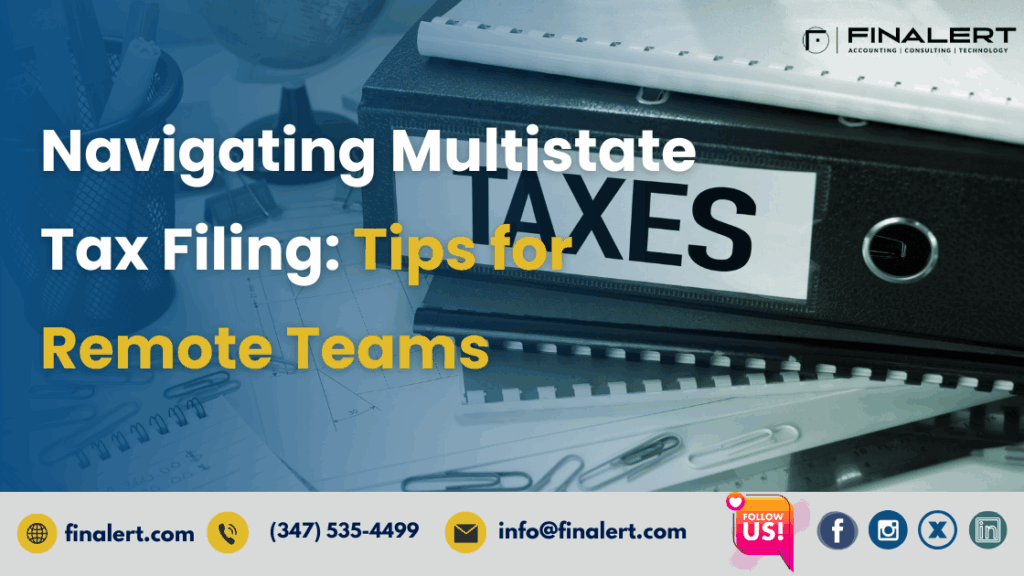
Remote work is no longer a trend; it’s the new normal. As U.S. businesses expand their hiring across state lines, many are encountering a complex web of multistate tax obligations they didn’t anticipate.
When your workforce operates from multiple states, it can create a nexus in each of those locations, triggering a wide range of tax responsibilities, including income tax withholding, payroll registration, unemployment insurance, and even sales tax implications. The regulatory landscape varies dramatically from state to state, and the IRS isn’t the only authority keeping watch.
This article is your comprehensive guide to navigating multistate tax filing with confidence. Whether you manage a startup with a distributed team or a growing SMB with hybrid operations, the tips below will help you stay compliant, minimize risk, and build a scalable tax strategy for your remote workforce.
Multistate tax filing refers to the process of filing tax returns and complying with tax laws in more than one state. When your company has employees, contractors, sales activity, or other operations in multiple states, you may be required to:
Each state has its own rules for determining tax obligations, which makes compliance for remote teams especially challenging.
When an employee works remotely in a state where your company has no other presence, that alone can trigger nexus—a legal connection that establishes a tax obligation. This can include:
Engaging remote contractors in other states may not create payroll tax obligations, but it can still trigger business registration or information return filing requirements. Some states have begun tightening enforcement even for non-employee workers.
Start by building a map of where your employees, contractors, customers, and physical or economic activities occur. Nexus can be created by:
Each state defines nexus differently, so review the criteria carefully.
Once you determine that a nexus exists, register your business with the relevant agencies in that state:
Failing to register can trigger noncompliance notices, back taxes, and fines.
Each employee must have the correct state income tax withheld based on their primary work location, which is typically their home for remote workers.
Ensure your payroll provider:
Some states require separate unemployment contributions even for one remote employee. SUI tax rates vary by industry, claim history, and location.
Tip: In most cases, only one state is entitled to SUI for a remote employee, typically the state where the employee works.
If your business earns revenue across multiple states and has nexus in each, you must apportion income correctly across those states. This usually involves formulas based on:
A miscalculation can lead to overpayment or underpayment of taxes.

To manage multiple jurisdictions, your business should leverage:
Avoiding penalties requires consistency and timely submissions.
Some states offer reciprocity agreements, allowing residents who work in neighboring states to avoid dual taxation. For example, an employee living in New Jersey but working in Pennsylvania may only pay taxes to one state, not both.
Work with a tax advisor to:
As remote work continues to redefine the way businesses operate, multistate tax compliance becomes a critical part of financial management. By understanding how remote employees trigger tax obligations and putting systems in place to manage registration, withholding, and filing, your business can scale across state lines with confidence.
At Finalert, we help businesses build strong compliance strategies that support remote growth, reduce risk, and simplify complex filings. If you’re navigating multistate operations in 2025, you don’t have to do it alone. Structure, software, and smart planning can keep you ahead of every jurisdiction.
Similar Articles
No results available
Get in touch with Finalert today for tailored business solutions!
No results available
Ready to thrive? Connect with Finalert today and let’s succeed together in the dynamic global market.
© 2025 Finalert. All rights reserved.
Ready to thrive in the dynamic global market? Finalert LLC offers expert financial services, including accounting, consulting, and technology solutions, tailored to your business needs.
Address
Accounting
Quick Links
Consulting
Industries
© 2025 Finalert LLC. All rights reserved.